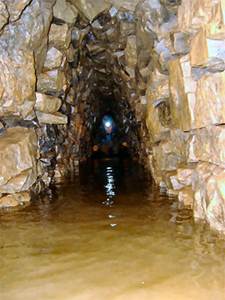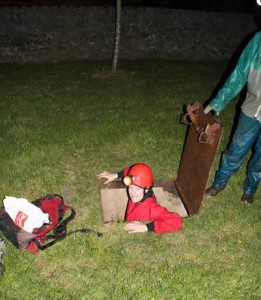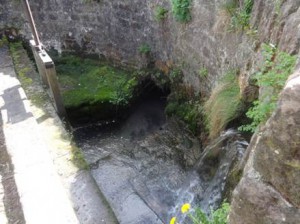
February 13, 2015, by Matt
Going Underground – exploring old mines in the Peak District
When Daniel Defoe travelled around Derbyshire during his tour of Great Britain in the late seventeenth century, he unexpectedly witnessed a miner emerging from a lead mine near Brassington: “we were agreeably surprised with seeing a hand, and then an arm, and quickly after a head, thrust up out of the very groove we were looking at” as the miner was “working and heaving himself up gradually” from his mine (Defoe 1726: Letter 8, part 2). For anyone present in the Artist’s Corner playground near Matlock, I must have presented a similar image as I hauled myself out of Youd’s Level and emerged next to the swings one Wednesday night.
As a historical geographer, I am more used to fieldwork in dusty archives than crawling around in the mud. Still, this is exactly what I find myself doing on a regular basis since I started my research project on the Derbyshire soughs – subterranean canals that drained water from the local lead mines. After spending a few months reading all about lead mines and soughs, I was keen to actually visit one and experience what it would have been like underground. The Peak District Mines Historical Society (PDMHS – pronounced: puddums) organises underground trips to mines with historical significance, so I contacted them to join the next caving trip. As it happened, there weren’t any outings planned that month, but my email was picked up by trip organiser Paul Chandler, who invited me along with his other group (the Masson Caving Group).
Our first trip earlier this year was to the Devonshire Cavern in Matlock Bath, a former lead mine that was converted to a show cavern in Victorian times. We clambered around in the surprisingly wide cavern as well as through narrow passages and viewed evidence of the lead mining industry, show cave tourism, and the climbing pins used for current recreational use of the cave. I was hooked, and went on a second trip which took me down into a sough. As our group waded through knee-deep water I realised just how much the miners must have been hindered by water during their work. Unprepared for this I was kindly lent a towel and dry socks by my fellow cavers at the end!
These and subsequent trips have been fun and adventurous activities, but also taught me a lot about being underground, the amount of pain-staking work required to construct a sough, and their importance in draining water from the mines. In addition, Paul was able to point out many interesting features of the mines (some were of historical significance, such as early gunpowder holes used in mining, while others were geological features such as small cave pools) and knew a lot about PDMHS’ role in conserving this subterranean heritage.
In short, while I had planned to go along only once, I now have my own helmet so it seems I found a new hobby!
Carry van Lieshout
Featured image is Inside Mandale Sough. Photo credit: Martin Long, PDMHS



If you’re interested in learning more about Derbyshire’s lead legacy and its impact on the hydrological landscape, there is a short video here: https://www.youtube.com/watch?v=A9GW5e-D7YI&feature=youtu.be